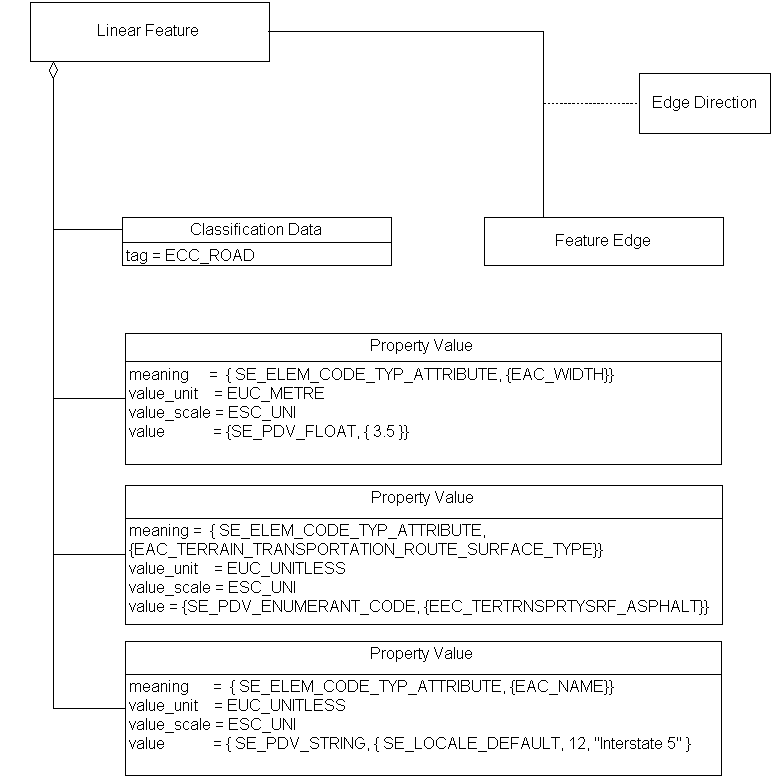The SEDRIS Data Representation Model
APPENDIX A - Classes
Linear Feature
|
|---|
Class Name: Linear Feature
Subclasses
This DRM class is concrete and has no subclasses.
Definition
An instance of this DRM class is a
<Primitive Feature> with a one-dimensional
structure, such as a road, a stream, or a power line.
Primary Page in DRM Diagram:
Secondary Pages in DRM Diagram:
Example
Consider a <Linear Feature> representing
a road.

This <Linear Feature> instance has an
ordered set of <Feature Edge> instances
defining the 2D or 3D path of its centreline. The
<Classification Data> identifies it
as a road, while the <Property Value>
instances describe the characteristics of the road.
Note that if individual segments of the road had different
surface characteristics, they could have been attributed with their
own <Property Value> components.
FAQs
- Can a <Linear Feature> consist of
multiple <Feature Edges>?
Yes. However, these
<Feature Edge> instances shall form an ordered
sequence, such that each consecutive pair of
<Feature Edge> instances
share a common <Feature Node>.
Also, any properties of the feature shall remain the same throughout its
length. For example, a single road feature (Interstate 95) could
conceivably consist of a linear sequence of hundreds or thousands of
<Feature Edge> instances.
Constraints
Associated to (one-way) (inherited)
Associated by (one-way) (inherited)
Associated with (two-way)
Composed of (two-way) (inherited)
Composed of (two-way metadata) (inherited)
Component of (two-way) (inherited)
Inherited Field Elements
This class has no inherited field elements.
Notes
Associated to Notes
An association between two <Feature Representation> instances
indicates that the environmental object(s) that they
represent have the semantic relationship indicated by
the <Base Association Data> instance on the association
relationship.
An association between a <Geometry Hierarchy> instance and
a <Feature Representation> instance indicates that the
environmental object(s) that they represent have the
semantic relationship indicated by the <Base Association Data>
instance on the association relationship.
An association between a <Property Grid> instance and a
<Feature Representation> instance indicates that the
environmental object(s) represented by the
<Feature Representation> instance and the <Property Grid> instance
(or some specific cell data within that <Property Grid> instance)
have the semantic relationship indicated by the
<Base Association Data> instance on the association relationship.
Each associated <Property Grid> instance will indicate whether the
entire <Property Grid> instance or only some specific cell data
within it is participating in the relationship in question.
Associated from Notes
An association between two <Feature Representation> instances
indicates that the environmental object(s) that they
represent have the semantic relationship indicated by
the <Base Association Data> instance on the association
relationship.
An association between a <Geometry Hierarchy> instance and
a <Feature Representation> instance indicates that the
environmental object(s) that they represent have the
semantic relationship indicated by the <Base Association Data>
instance on the association relationship.
An association between a <Property Grid> instance and a
<Feature Representation> instance indicates that the
environmental object(s) represented by the
<Feature Representation> instance and the <Property Grid> instance
(or some specific cell data within that <Property Grid> instance)
have the semantic relationship indicated by the
<Base Association Data> instance on the association relationship.
Each associated <Property Grid> instance will indicate whether the
entire <Property Grid> instance or only some specific cell data
within it is participating in the relationship in question.
Composed of Notes
These components support *attributes for derived objects*; that
is, they are used only to specify texture mapping information
for geometry that is derived from the <Primitive Feature> by
the consumer. These <Image Mapping Function> components shall use
<Image Anchor> components to specify the mapping.
This is needed because in many cases, a <Primitive Feature> may be
significant only for a particular domain, such as radar.
Prev: Lineage.
Next: Linear Geometry.
Up:Index.
|
Last updated: July 16, 2004
|
Copyright © 2004 SEDRIS™
|
|
